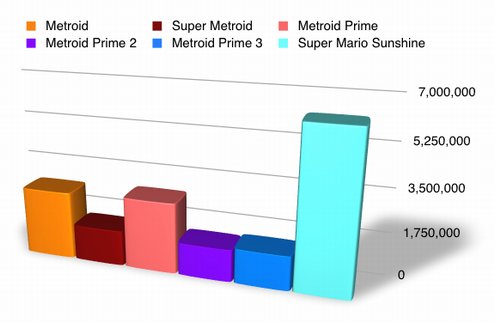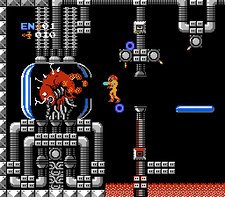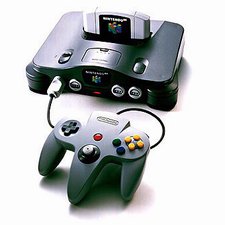 Okay, so Metroid isn’t exactly a commercial flop. But if Samus ever decides to spend some social time with Mario and Link, she’d better keep a thick skin; they’d chuckle at her comparatively modest sales.
Okay, so Metroid isn’t exactly a commercial flop. But if Samus ever decides to spend some social time with Mario and Link, she’d better keep a thick skin; they’d chuckle at her comparatively modest sales.
Within the overall industry picture, the Metroid series has always been successful. But by Nintendo’s standards, it has failed to captivate the amount of players the company’s other premier franchises have. On Wii alone, Super Mario Galaxy has more than tripled the worldwide sales of Metroid Prime 3: Corruption, and so has Twilight Princess.
More anecdotally, it seems the critically acclaimed Metroid series continually fails to match the hype of competing franchises, even some less than half its age. But there are reasons Metroid has always been stuck in a squeamish spot between commercial disappointment and breakthrough success…and why it may always remain there.

This chart compares the worldwide sales of the Metroid series’ major console games relative to those of Super Mario Sunshine, the lowest-selling console Mario platformer ever. Released in 2002, Super Mario Sunshine has since sold 6.28 million copies worldwide, far fewer than any other proper Mario sequel but more than double the sales of Metroid’s most successful game, Metroid Prime.
Of course, pitting most video game series against the behemoth Mario franchise would result in unfair sales comparisons, but it does prove a point. When a mascot can, at his worst, double the sales of another, at her best, something is likely wrong with the latter.
Now, let’s be fair. There really is nothing wrong with the Metroid games. Rather, they often represent the pinnacle of immersive and atmospheric gaming. But by my estimations, there are three main reasons for the Metroid series’ lack of success relative to others.
3. The Niche-Factor
 Most iconic video game series have blemishes their creators would likely love to forget. Castlevania, Sonic the Hedgehog, and even Nintendo’s own (Star Fox, anyone?) have skeletons in their closets. But gamers would be faced with a logical fallacy if tasked with finding a “bad Metroid game.” Save your energy; it doesn’t exist.
Most iconic video game series have blemishes their creators would likely love to forget. Castlevania, Sonic the Hedgehog, and even Nintendo’s own (Star Fox, anyone?) have skeletons in their closets. But gamers would be faced with a logical fallacy if tasked with finding a “bad Metroid game.” Save your energy; it doesn’t exist.
Just about every one of Samus Aran’s adventures has been received with glowing reviews over the years. So why hasn’t the series’ oft-praised, award-winning gameplay captured a larger audience?
Despite their quality, Metroid games aren’t exactly mainstream-friendly. The series’ standard has become to abandon players on a strange, isolated alien world to explore silent landscapes devoid of friendly life. The games offer no direct guidance; players are left to their own devices to discover what to do, where to go and how to get there. Given the massive size of the environments, the labyrinthine design of the passageways and the relative infrequency of enemy fire, Metroid games can be a downright bleak and protracted affair.
Of course, this is a critical part of the atmosphere that has come to define the series over the years, and the Metroid faithful wouldn’t have it any other way. But sales indicate the Metroid formula is a sharp contrast to those favored by the typical gamer, the one upon whom the industry’s biggest successes rely. While Nintendo positions the series alongside blockbusters like Mario and Zelda, Metroid has never subscribed to a mainstream formula, and the experiences it has offered over the years have crafted their own modest market niche.
2. The Disappearance
 Halo 3. Call of Duty 4. Guitar Hero 3. The list goes on; for a video game series to be huge, it usually needs to break through as a prominent name by releasing consistent sequels. It’s just the nature of the industry.
Halo 3. Call of Duty 4. Guitar Hero 3. The list goes on; for a video game series to be huge, it usually needs to break through as a prominent name by releasing consistent sequels. It’s just the nature of the industry.
Her nearly decade-long absence likely had a substantial negative impact on the profitability of Samus Aran.
Throughout both the NES and Super NES generations, Metroid had been one of Nintendo’s premier franchises. When Nintendo made the leap to 3D gaming with the Nintendo 64 console, it brought those premier franchises along for the ride and, in the process, created two of the finest games in the history of the medium. Super Mario 64 and the Legend of Zelda: Ocarina of Time represented a new standard for Nintendo-developed titles, as well as gaming in general. But where was Metroid?
After her appearance in 1994’s Super Metroid, Samus Aran would disappear from gaming, save for an occasional cameo role, for almost a decade before being revived in 2002’s Metroid Prime, the series’ best-selling game. While the sales of Metroid Prime may indicate her sabbatical had no effect on her appeal, their modest stature in comparison to other Nintendo franchises suggests the opposite.
Had Metroid been nurtured with uninterrupted limelight treatment for two decades, as both Mario and Zelda have been, the series’ best-selling figure might have been much higher than Metroid Prime’s 2.83 million worldwide. A lot can happen in eight years, and it is possible that many either forgot about the series or lost interest.
1. The Marketing
 Speaking of limelight treatment, it might be worth passing a memo through the offices of Nintendo HQ; it’s okay to promote games that don’t have “Wii” in their titles, too.
Speaking of limelight treatment, it might be worth passing a memo through the offices of Nintendo HQ; it’s okay to promote games that don’t have “Wii” in their titles, too.
Jack disagrees with me on this one, but I stand my ground. When it comes to advertising for Metroid, one of its strongest franchises, Nintendo executives are asleep at the wheel.
Contrast the advertising efforts for the original Metroid Prime against those for the latest, Metroid Prime 3. In 2002, Nintendo of America wholly supported the outstanding efforts of then-unknown Retro Studios with seemingly endless media and public relations efforts, not to mention a national advertising campaign headed by the high-budget, absurdly sweet and relevant television ad seen below.
[youtube]http://www.youtube.com/watch?v=op-1liVGcxM[/youtube]
As for Metroid Prime 3, the opposite was true. Aside from devout Nintendo fans, few people had any idea a mature game of such high caliber was coming to Wii. The now infamous television promotions were lackluster at best, showcasing the game in a short ad with few videos and highlighted with the casual-friendly “Wii would like to play” banner. Not only did these ads understate the significance of the game, but they failed to express its essence and appeal, something accomplished ten-fold with the original Prime ad.
Nintendo’s approach to Metroid Prime 3 promotion was most abhorrent in terms of its media outreach. Though the game had first been revealed at E3 2005, major gaming outlets had been given little hands-on time with the game prior to its Aug. 2007 release. IGN’s Matt Casamassina reported only 19 days prior to the game’s launch that Nintendo had provided only three chances for hands-on time with the game, with one session limited to less than ten minutes.
People can’t get excited for a game they know nothing about.
Nintendo is making money. Mad money, in fact, and I’m sure many will argue the last thing Nintendo should worry about is the lackluster sales of Metroid relative to blockbuster casual titles like Wii Sports, Wii Fit and Wii Play. But ignoring established franchises is anything but a reasonable business decision. Nintendo should, at the very least, put some comparable effort behind the next Metroid.
No single reason is strictly to blame for Metroid’s respectable, “on-the-brink” success. It really is the result of each of these reasons equally, not to mention others we’ve skipped here. But a question remains: should the series be expected to sell better than it does, or is Metroid destined for the niche market status it currently holds?
Whatever the case, at least a few of us will be anxiously awaiting Samus’ next outing, no matter how many more millions Mario’s and Link’s will sell.
(Author’s note: All above sales figures are worldwide totals and were taken from video game sales tracking Web site VGChartz.com.)
